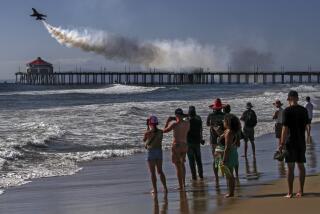Purse Seine Crews, Spotters Squabble Over Pilots’ Cut
- Share via
For Tom Greene, work means taking off from Torrance airport in his white Cessna 175 and scouring the Pacific for fish. When he spies a lucrative school, he calls his clients, members of the San Pedro purse seine fleet.
Greene is one of half a dozen pilots who scout Southern California waters for the region’s 30 or so seiners, who net mackerel, bonito, tuna and squid for canning.
At first glance, the relationship would seem happily symbiotic: For a 6% share of the catch, spotter planes lead seiners directly to the fish, saving them valuable time and fuel.
But unions representing purse seine crews want pilots to reduce their cut. On top of the boat owners’ share, plus the cost of fuel and other essentials, the unions say, spotter plane costs leave too little for the crew members.
“The (crews’) paycheck is shrunk to nothing,” said John Royal, an official with one of two unions that represent purse seine crews. “The guys are working for the fuel companies and the airplanes. . . . They’re the ones doing all the labor and sweat.”
Faced with such sentiment, Assemblyman Gerald N. Felando (R-San Pedro), who is known for his support of the fishing industry, weighed into the dispute. He has threatened to seek a ban on spotter planes if the pilots fail to strike a deal with the fleet, half of which is unionized.
The move appears to have had an effect. In recent weeks, the pilots have offered to make concessions. For one, they will take a smaller share of squid sales.
The offers, which will be presented in writing to the unions in San Pedro on Monday, were not made lightly. Pilots say they’re feeling the economic pinch just as much as the purse seiners and argue they’re incapable of offering more. Said Greene: “We’re trimmed out.”
The position of boat owners, meanwhile, is tough to pin down. In interviews, several expressed satisfaction with the spotter pilots, attributing the union complaints to poor fishing of late and tight state curbs on the harvest of sardines.
Felando and Royal, however, said last week that the boat owners are dissatisfied, but will not say so publicly for fear of being shunned by the pilots they need to lead them to fish.
“The boat owners are intimidated. They complain and (gripe) to me, but when the pilots are around they dummy up,” said Royal.
Controversy involving spotter planes is nothing new. In 1988, Alaska banned them in its salmon fishery after some fishermen complained that they were at an unfair disadvantage because they could not afford the pilots.
The statewide prohibition was repealed in 1989 but has since been replaced by salmon spotting bans affecting Prince William Sound and Bristol Bay, says Bill Cheney, a regulator with the state’s Department of Fish and Game.
In California, a ban on spotters in the swordfish industry was imposed for similar reasons in 1976. It was relaxed somewhat during the next year. And in 1984 it was rescinded completely after the harpoon fishermen who had used the planes argued that they were being squeezed out by a then-nascent gill net fleet targeting swordfish.
“In order to compete, they needed the airplanes back,” said Rick Klingbeil, a biologist with the state Department of Fish and Game.
Although spotters for the purse seine fleet--which fishes largely out of San Pedro with a few boats from Port Hueneme--have never been banned, they have experienced their share of tensions. Three years ago, pilots acknowledged, a turf battle between spotters serving different groups of boats in the San Pedro fleet caused trouble at sea.
They say a plane tried to scare fish away from a boat in an adversary’s group by swooping low over the water and, on another occasion, by dropping a cherry bomb.
“From what I used to hear, it sounded like Richthofen’s flying circus out there,” said James Squire, a biologist with the National Marine Fisheries Service.
Boat owners, crew members and pilots say such incidents have not been repeated. The main issue now is a straightforward question of how much--and in what manner--spotter pilots should charge for their services.
For the last two years, an agreement between boat owners and spotters have allowed the pilots a flat 6% share of gross fish sales--an increase of 1% over previous levels. Boat owners and the 10-person crews usually split what’s left after paying for fuel and other costs.
Union crews want to enforce an old contract that restricts pilots to 5% from the crews’ share after trip expenses have been deducted. The unions say all of the pilots’ 1% increase should come from the owners’ share.
But in the last two years--a period of poor fishing--deck hands have often been forced to pay 6% of their share, the union officials say.
“The problem is that when things are tight, everything seems to get pushed off to the workingman,” said Terry Hoinsky, president of the other union representing crew members.
Greene, part of a four-pilot group that flies out of the Los Angeles area--another group of two pilots flies from Ventura County--said that if this is the case, it is nothing new. The union contract with boat owners is more than a decade old, he pointed out, and he questioned why the unions bring up the issue now.
Another union complaint is that when a boat takes a tip from a spotter pilot who normally flies for another group of boats, the seiner has to pay twice; 6% for the outside help on top of the 6% due the boat’s regular pilot.
“If that happens, on an average night we could lose $50 each,” said Sal Ferrigno, a crew member aboard a purse seine boat owned by his father, Joe Ferrigno. “That adds up if it happens two or three times a month.”
Crew members make an average of $14,000 to $16,000 a year, according to the San Pedro Fishermen’s Cooperative, and during the same period, a pilot will earn about $22,000 from each boat for which he spots.
In an apparent attempt to force pilots to address these concerns, Felando filed legislation this year prohibiting the use of aircraft to assist fishermen.
Since then, the spotter pilots have offered to cut their share of gross squid sales money to 4% after boat expenses and to stop spotting for boats outside their group. The pilots say they made the concession on squid, because the seiners already have to share part of their income with vessels that use powerful lights to attract squid.
For the moment, the move by the pilots seems to have gotten Felando to remove his threat. Last week, he struck the provision for a spotter plane ban from his bill.
But the South Bay Republican said he could change his course. “If it gets to the point where they are running extortion on the boats, then, yeah, I’d want to get rid of them,” Felando said.
Tom Crehan of the cooperative said boat owners will support the pilots proposal if unions agree to it.
Spotter pilots, however, remain skeptical of the need for a new payment scheme, particularly the pledge not to spot for boats outside their group.
Purse seiners, Greene said, will end up losing on the deal: “If I could show you where to find hundred dollar bills, wouldn’t you give me 6%?”
More to Read
Sign up for Essential California
The most important California stories and recommendations in your inbox every morning.
You may occasionally receive promotional content from the Los Angeles Times.










